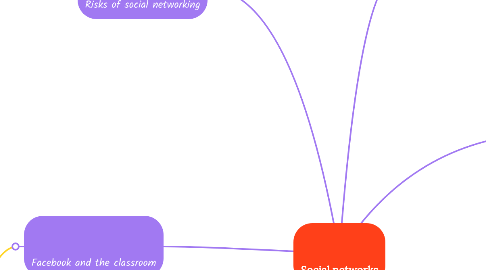
1. Risks of social networking
1.1. Overuse of SN may cause depression and anxiety; parents can get addicted to games and neglect their children
1.1.1. A common misuse: occasionally used to emotionally abuse individuals (trolling)
1.1.2. Online bullying, also called cyber-bullying, is a relatively common occurrence and it can often result in emotional trauma for the victim
1.1.3. Users of these services also need to be aware of data theft or viruses.
2. social media
2.1. computer-mediated tools that allow people to create, share or exchange information in virtual communities and networks
2.2. magazines, Internet forums, weblogs, social blogs, microblogging, wikis, social networks, podcasts, photographs or pictures, video, rating and social bookmarking
3. Social networks and education
3.1. Many school have blocked access to SNS within the school environment
3.2. Social networking is allowing scientific groups to expand their knowledge base and share ideas
3.3. teachers can provide new opportunities for enriching existing curriculum through creative, authentic and flexible, non-linear learning experiences
3.4. Advantages: - SNs are global and 24/7. - SNs create friends which lead to face to face meetings. - Share worksheets/mind maps for students, time-saving. - Non-native teachers are also exposed to real language in the modern world
3.5. Disadvantages: - All SNs are time-consuming. - Some teachers find SNs too daunting to tackle. - SNs can become addictive. - Students become obsessed in finding their teachers on a SN and intrude in teachers’ private lives
4. A social networking service (social networking site or SNS)
4.1. a platform to build social networks or social relations among people who share interests, activities, backgrounds or real-life connections
4.1.1. SNS allows: - to comment profiles; - to send private messages; - to traverse the extended web of friends visible in each member’s profile
4.1.2. a profile, social links, and a variety of additional services
4.1.3. web-based and provide means for users to interact over the Internet, such as e-mail and instant messaging
4.1.4. The earliest online social networks is USENET in 1979
4.1.5. allow individuals to: construct a public/semi-public profile; articulate a list of other users that they share a connection with; view their list of connections within the system
5. Facebook and the classroom
5.1. an online social networking service, launched in 2004
5.1.1. USAGE: users can create a user profile, add other users as "friends", exchange messages, post status updates and photos, share videos and receive notifications when others update their profiles
5.1.2. provides the facility of individual and group interaction to its users
5.1.3. allows for both an asynchronous and synchronous, open dialogue via a familiar and regularly accessed medium, and supports the integration of multimodal content
5.1.4. useful in language learning, because they are more engaging and inspiring for learners to use the target language, and minimizes learners’ fear and nervousness and authority of the instructor
